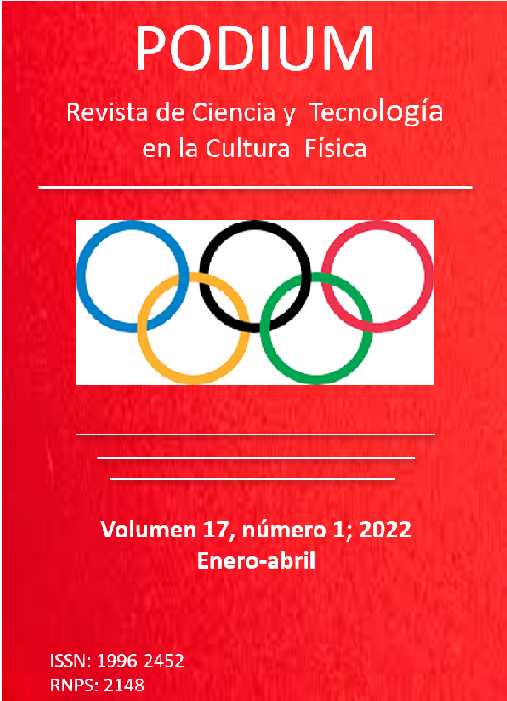A rentabilidade da conversão de nadadores para o estilo livre
##plugins.themes.bootstrap3.article.main##
Resumo
Downloads
##plugins.themes.bootstrap3.article.details##
Referências
Absaliamov, T. (1990). Análisis de la actividad competitiva del nadador. En Aseguramiento científico de la preparación de nadadores (pp. 58-51). Vneshtorgizdat.
Arellano Colomina, R., Navarro Valdivieso, F., Federaciión Española de Natación, & Escuela Nacional de Entrenadores. (2010). Entrenamiento t??cnico de nataci??n. Cultivalibros. https://www.worldcat.org/title/entrenamiento-tecnico-de-natacion/oclc/793259902
Arroyo Zambrano, A. A. (2018). Guía elemental de la biomecánica, para el desarrollo del tren inferior, en la salida, del estilo libre, de la natación. UTMACH, Unidad Académica de Ciencias Sociales, Machala. http://repositorio.utmachala.edu.ec/handle/48000/12080
Becerra, A. T. (2014). Factores limitantes del rendimiento en un 50 libre. E-motion: Revista de Educación, Motricidad e Investigación, 3, 141-154. https://dialnet.unirioja.es/servlet/articulo?codigo=4867656
Blazevich, A. (2021). They sciencie of underwater swimming. Edith Cowan University.
Born, D.-P., Kuger, J., Polach, M., & Romann, M. (2021). Turn Fast and Win: The Importance of Acyclic Phases in Top-Elite Female Swimmers. Sports, 9(9), 122. https://doi.org/10.3390/sports9090122
Chainok, P., Machado, L., de Jesus, K., Abraldes, J. A., Borgonovo-Santos, M., Fernandes, R. J., & Vilas-Boas, J. P. (2021). Backstroke to Breaststroke Turning Performance in Age-Group Swimmers: Hydrodynamic Characteristics and Pull-Out Strategy. International Journal of Environmental Research and Public Health, 18(4), 1858. https://doi.org/10.3390/ijerph18041858
Dies, J. O. (2015). Análisis del Viraje en Natación. G-SE. https://g-se.com/analisis-del-viraje-en-natacion-bp-357cfb26db011e
Donoghue, O. A., Shimojo, H., & Takagi, H. (2011). Impact forces of plyometric exercises performed on land and in water. Sports Health, 3(3), 303-309. https://doi.org/10.1177/1941738111403872
Gonjo, T., & Olstad, B. H. (2020). Start and Turn Performances of Competitive Swimmers in Sprint Butterfly Swimming. Journal of Sports Science and Medicine, 19(4), 727-734. https://www.jssm.org/jssm-19-727.xml%3Eabst
Lewin, G. (1985). Natación Deportiva. Editorial Científico Técnico.
Maza Castillo, D. S. (2017). La natación como aporte al mejoramiento del estilo libre dirigido al personal policial de la subzona el oro. UTMACH, Unidad Académica de Ciencias Sociales, Machala. http://repositorio.utmachala.edu.ec/handle/48000/11156
Nicol, E., Ball, K., & Tor, E. (2021). The biomechanics of freestyle and butterfly turn technique in elite swimmers. Sports Biomechanics, 20(4), 444-457. https://doi.org/10.1080/14763141.2018.1561930
Nugent, F. J., Comyns, T. M., & Warrington, G. D. (2018). Strength and Conditioning Considerations for Youth Swimmers. Strength & Conditioning Journal, 40(2), 31-39. https://doi.org/10.1519/SSC.0000000000000368
Oliveira, T., Torriani-Pasin, C., Silva, S., Denardi, R., Madureira, F., Apolinário, M., & Corrêa, U. (2014). The spatiotemporal constraint on the swimmer's decision-making of turning. Motricidade, 10, 90-98. https://doi.org/10.6063/motricidade.10(3).3052
Ramírez, E. (2015). Análisis de las variables determinantes del rendimiento en la prueba de 50 metros libres en la natación competitiva. Lecturas: Educación física y deportes, 205, 1-5. https://dialnet.unirioja.es/servlet/articulo?codigo=5219637
Ramos Rojas, M., Miló Dubé, M., González Corrales, S. C., Ramos Rojas, M., Miló Dubé, M., & González Corrales, S. C. (2020). Diagnóstico para perfeccionar la fuerza especial en agua de polo acuático en Pinar del Río. Podium. Revista de Ciencia y Tecnología en la Cultura Física, 15(2), 250-262. http://scielo.sld.cu/scielo.php?script=sci_abstract&pid=S1996 -24522020000200250&lng=es&nrm=iso&tlng=es
Rejman, M., & Borowska, G. (2008). Searching for Criteria in Evaluating the Monofin Swimming Turn from the Perspective of Coaching and Improving Technique. Journal of Sports Science & Medicine, 7(1), 67. https://www.ncbi.nlm.nih.gov/pmc/articles/PMC3763354/
Valentina, S., Dubosiene, M., Dubosas, M., & Eidukeviciute, M. (2017). The Relationship between Different Age Swimmers’ Flip Turn Tem-poral and Kinematic Characteristics. Mechanics, 23(4). https://doi.org/10.5755/j01.mech.23.4.17852
Takeda, T., Sakai, S., & Takagi, H. (2020). Underwater flutter kicking causes deceleration in start and turn segments of front crawl. Sports Biomechanics, 1-10. https://doi.org/10.1080/14763141.2020.1747528
Trinidad, A., Veiga, S., Navarro, E., & Lorenzo, A. (2020). The Transition from Underwater to Surface Swimming During the Push-off Start in Competitive Swimmers. Journal of Human Kinetics, 72, 61-67. https://doi.org/10.2478/hukin-2019-0125
Valentina, S., Dubosiene, M., Dubosas, M., & Eidukeviciute, M. (2017). The Relationship between Different Age Swimmers' Flip Turn Tem-poral and Kinematic Characteristics. Mechanics, 23(4). https://doi.org/10.5755/j01.mech.23.4.17852
Veiga, S., & Roig, A. (2017). Effect of the starting and turning performances on the subsequent swimming parameters of elite swimmers. Sports Biomechanics, 16(1), 34-44. https://doi.org/10.1080/14763141.2016.1179782
Weimar, W., Sumner, A., Romer, B., Fox, J., Rehm, J., Decoux, B., & Patel, J. (2019). Kinetic Analysis of Swimming Flip-Turn Push-Off Techniques. Sports, 7(2), 32. https://doi.org/10.3390/sports7020032
Yero, L. V. F., Rodríguez, R. M. T., & Martínez, R. G. (2016). Sistema de ejercicios para perfeccionar los virajes del combinado individual en nadadores 9-10 años provincia Granma (Original). Revista científica Olimpia, 13(41), 169-178. https://revistas.udg.co.cu/index.php/olimpia/article/view/1300


